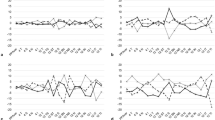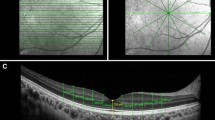Abstract
Purpose
A new clinical ultrahigh-resolution spectral domain optical coherence tomography (UHR-SD-OCT) system using an original averaging technique named “A-scan matching algorithm” was developed. The aim of this study was to determine whether our new UHR-SD-OCT system can obtain clearer sectional images of the retina than conventional standard resolution SD-OCT systems (SR-SD-OCT).
Methods
We recorded horizontal B-scan images of 42 normal eyes using our new UHR-SD-OCT device (Bi-μ, Kowa) and a conventional SR-SD-OCT (Spectralis, Heidelberg). To evaluate the clarity of the interdigitation zone (IZ) subjectively, the integrity of IZ was divided into three types by two raters. To evaluate the clarity of the IZ objectively, a peak height score (PHS) was calculated at five different points of the macula using the longitudinal reflectivity profile.
Results
The mean (± SD) of the subjective visibility score of the IZ in the UHR-SD-OCT images was 2.64 ± 0.54 which was significantly higher than the 2.46 ± 0.46 in the SR-SD-OCT images (P = 0.02). The PHS was also significantly higher for the UHR-SD-OCT than for the SR-SD-OCT images at all five locations (all P < 0.01).
Conclusion
The results indicate that the newly developed clinical UHR-SD-OCT instrument using the A-scan matching algorithm can obtain clearer images of the IZ, and they suggest that this device should be clinically useful in detecting finer structural abnormalities of the outer retina.







Similar content being viewed by others
References
Drexler W, Fujimoto JG (2008) State-of-the-art retinal optical coherence tomography. Prog Retin Eye Res 27:45–88
Fujimoto JG (2003) Optical coherence tomography for ultrahigh resolution in vivo imaging. Nat Biotechnol 21:1361–1367
Drexler W (2004) Ultrahigh-resolution optical coherence tomography. J Biomed Opt 9:47–74
Staurenghi G, Sadda S, Chakravarthy U, Spaide RF (2014) International Nomenclature for Optical Coherence Tomography (IN•OCT) Panel. Proposed lexicon for anatomic landmarks in normal posterior segment spectral-domain optical coherence tomography: the IN•OCT consensus. Ophthalmology 121:1572–1578
Cideciyan AV, Hufnagel RB, Carroll J, Sumaroka A, Luo X, Schwartz SB et al (2013) Human cone visual pigment deletions spare sufficient photoreceptors to warrant gene therapy. Hum Gene Ther 24:993–1006
Matsui Y, Matsubara H, Ueno S, Ito Y, Terasaki H, Kondo M (2014) Changes in outer retinal microstructures during six month period in eyes with acute zonal occult outer retinopathy-complex. PLoS One 9:e110592
Burgess R, Millar ID, Leroy BP, Urquhart JE, Fearon IM, De Baere E et al (2008) Biallelic mutation of BEST1 causes a distinct retinopathy in humans. Am J Hum Genet 82:19–31
Park JH, Lee SM, Park SW, Lee JE, Byon IS (2018) Comparative analysis of large macular hole surgeries using an internal limiting membrane: insertion technique versus inverted flap technique. Br J Ophthalmol. https://doi.org/10.1136/bjophthalmol-2017-311770
Drexler W, Morgner U, Kärtner FX, Pitris C, Boppart SA, Li XD et al (1999) In vivo ultrahigh-resolution optical coherence tomography. Opt Lett 24:1221–1223
Morgner U, Drexler W, Kärtner FX, Li XD, Pitris C, Ippen EP et al (2000) Spectroscopic optical coherence tomography. Opt Lett 25:111–113
Jørgensen TM, Thomadsen J, Christensen U, Soliman W, Sander B (2007) Enhancing the signal-to-noise ratio in ophthalmic optical coherence tomography by image registration method and clinical examples. J Biomed Opt 12:041208
Chen M, Lang A, Ying HS, Calabresi PA, Prince JL, Carass A (2014) Analysis of macular OCT images using deformable registration. Biomed Opt Express 5:2196–2214
Zhang H, Li Z, Wang X, Zhang X (2015) Speckle reduction in optical coherence tomography by two-step image registration. J Biomed Opt 20:036013
Rii T, Itoh Y, Inoue M, Hirakata A (2012) Foveal cone outer segment tips line and disruption artifacts in spectral-domain optical coherence tomographic images of normal eyes. Am J Ophthalmol 153:524–529
Terasaki H, Shirasawa M, Yamashita T, Yamashita T, Yamakiri K, Sonoda S et al (2012) Comparison of foveal microstructure imaging with different spectral domain optical coherence tomography machines. Ophthalmology 119:2319–2327
Tsunoda K, Usui T, Hatase T, Yamai S, Fujinami K, Hanazono G et al (2012) Clinical characteristics of occult macular dystrophy in family with mutation of RP1l1 gene. Retina 32:1135–1147
Fujita K, Shinoda K, Imamura Y, Matsumoto CS, Mizutani Y, Mizota A et al (2012) Correlation of integrity of cone outer segment tips line with retinal sensitivity after half-dose photodynamic therapy for chronic central serous chorioretinopathy. Am J Ophthalmol 154:579–585
Itoh Y, Inoue M, Rii T, Hirota K, Hirakata A (2013) Correlation between foveal cone outer segment tips line and visual recovery after epiretinal membrane surgery. Invest Ophthalmol Vis Sci 54:7302–7208
Acknowledgements
We thank Professor Duco I. Hamasaki of the Bascom Palmer Eye Institute of the University of Miami and Professor Artur V. Cideciyan of the Scheie Eye Institute of the University of Pennsylvania for critical discussion and final manuscript revisions. We also thank Masaharu Mizuochi and Toshiaki Nakagawa of Kowa Company for technical support.
Funding
We thank the Grant-in-Aid for Scientific Research C (MK, 17K19721) from the Ministry of Education, Culture, Sports, Science and Technology of Japan. (http://www.jsps.go.jp/).
Author information
Authors and Affiliations
Corresponding author
Ethics declarations
Conflict of interest
YM received honoraria from Alcon, Bayer, Hoya, Kowa, Novartis, Santen, and Senju. MK is a consultant to Senjyu and Bayer, and received financial research support from Alcon, AMO Japan, Hoya, Kowa, Nidek, Novartis, Otsuka, Pfizer, Santen, and Senju, and honoraria from Alcon, Bayer, Hoya, Kowa, Nidek, Novartis, Otsuka, Pfizer, Sanofi, Santen, Sanwa, and Senju. HM received financial research support from Novartis and honoraria from Alcon, Bayer, Novartis, and Santen. Other authors have no financial disclosures.
Ethical approval
All procedures performed in studies involving human participants were in accordance with the ethical standards of the institutional and/or national research committee and with the 1964 Helsinki declaration and its later amendments or comparable ethical standards. Informed consent was obtained from all individual participants included in the study.
Rights and permissions
About this article
Cite this article
Matsui, Y., Kondo, M., Uchiyama, E. et al. New clinical ultrahigh-resolution SD-OCT using A-scan matching algorithm. Graefes Arch Clin Exp Ophthalmol 257, 255–263 (2019). https://doi.org/10.1007/s00417-018-4183-6
Received:
Revised:
Accepted:
Published:
Issue Date:
DOI: https://doi.org/10.1007/s00417-018-4183-6




